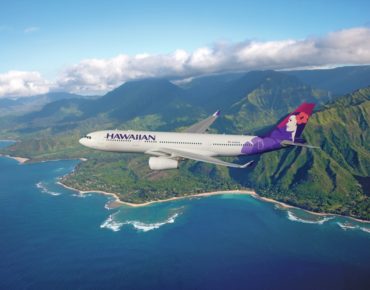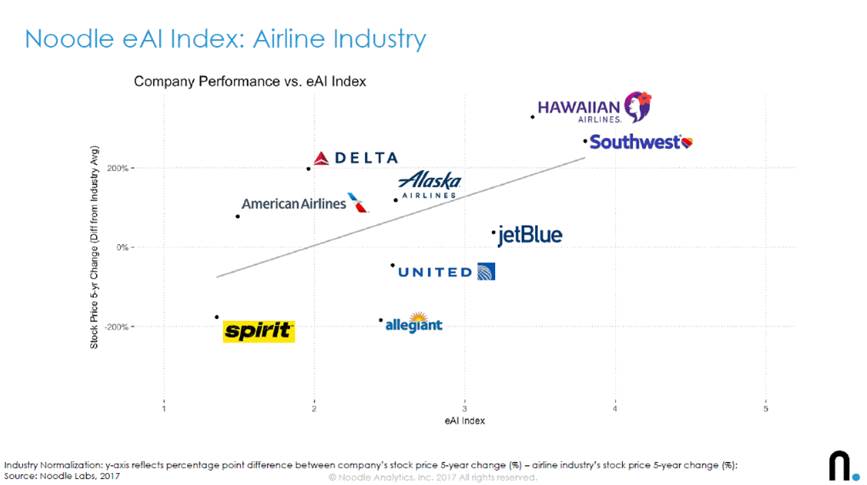Airlines Embracing AI Take Wing, AI Index Finds

Stock prices of airline companies – starting with Southwest and Hawaiian airlines – that have embraced AI look like the flight path of a plane just after take-off: steady ascent.
In fact, a growing divide is emerging between airlines that have, and have not, applied predictive analytics and learning algorithms to ticketing, maintenance, scheduling, pricing and other operations, one that CEO Stephen Pratt of Noodle.ai, which has developed an eAI Index (Enterprise Artificial Intelligence Index) for the airline industry, asserts will result in a competitive domino effect.
“We’re noticing an increasing divide between the haves and have-nots that’s getting more and more dramatic – the AI divide,” Pratt told EntepriseTech. It’s a gap he believes will widen as the capabilities of learning algorithms used by the “haves” progress. “If you can anticipate customer demand, if you can price better, maintain your fleet better, develop a better schedule, you’re going to have a better run airline with happier customers and investors.”
By contrast, he said, are the airlines lagging in their adoption of AI that still use backward-looking “static” algorithms that rely on limited sources of internal data. “They’re making educated guesses based on a finger in the air approach to what’s going to happen.
“What’s happening is that as airlines adopting these learning algorithms are competing with companies using static algorithms, pretty soon the dominoes will begin to fall,” Pratt said. “A static algorithm competing with a learning algorithm isn’t a fair fight.”
Like a supersonic fighter jet in a dogfight with a prop plane.
Pratt emphasized the distinction between AI versus big data analytics.
“AI is not the same thing as big data,” he said. “The AI community has this running commentary that big data means, “Great, more data you’re not going to do anything with.’ We’re all about what you actually are going to do with all that data, as opposed to accumulating it.”
Noodle.ai is an AI solutions provider for enterprises, and Pratt freely admits that the eAI Index is a marketing tool to draw attention from the airline industry, in which Noodle.ai has consulting experience. So take the index with as many grains of salt as you wish. But Pratt asserts there is a strong correlation between AI adoption and airline performance – and stock value.
He said the eAI Index is based on four areas of AI adoption (based on publicly available information, such as media coverage, annual reports and press releases):
- Use of learning algorithms and advanced analytics
- Use of supercomputing (such as large-scale CPU clusters and GPU-driven systems) technology for AI
- Data engineers on staff with advanced AI skills capable of manipulating high volumes of data
- A visible commitment to AI communicated to investors, employees and the public
A measure of the industry’s complexity is the number of “origin-destination pairs” (i.e., flights) that airlines manage every day. Major carriers have up to 100,000 of them, Pratt said, the prices for which can be changed six times per day, that can have 20 different fares per flight, with initial pricing set 330 days in advance. Doing the math, that amounts to billions of possible price changes across tens of thousands of flight all done in the service of a key airline business metric: Passenger Revenue per Available Seat Mile (PRASM).
“It’s an impossible task,” Pratt said. “Moving toward use of learning algorithms while processing a lot of internal and external data is critically important.”
Looking at Southwest Airlines, Pratt said the company scored high AI marks in part for its utilization of both structured and unstructured data. “They’re doing a lot of work in social media and natural language processing and speech analytics around customer interactions to develop offers to do predictive analytics around what their customers want. They’ve shown a strong overall migration toward analytics, and putting in the computing infrastructure needed.”
He noted that Southwest was one of first airlines to offer custom pricing to individual customers, in part because the company sells tickets primarily through its web site, rather than global distribution systems, such as Expedia or American Express.
Pratt cited lack of AI skills on staff along with “management attention” as the key barriers to airline adoption of AI. “Introducing new ways that will change the operations of the company are very challenging, it takes a lot of executive leadership to say ‘We believe in lots of data and advanced algorithms and supercomputing as a potential differentiator.”
Having said that, he said there is plenty of fertile ground for AI in the areas of pricing and inventory allocation. But Pratt recommends against adoption of chatbots for customer service as a first step toward AI, despite the attention they have received.
“Some (AI) laggards are toying with chatbots, but they are incredibly difficult to do, very expensive and of dubious value,” he said. Some are saying, ‘Let’s do an AI project, let’s do a chatbot.’ In my opinion, that’s the worst place you can start.”











